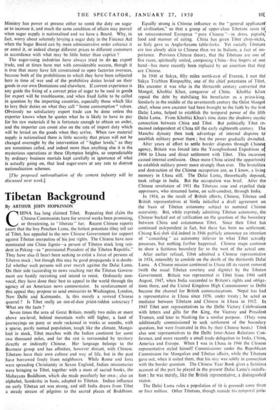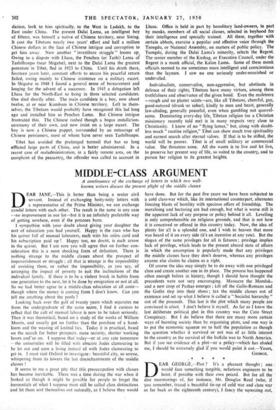Tibetan Background
By ARTHUR JOHN HOPKINSON
CHINA has long claimed Tibet. Repeating that claim the Chinese Communists have for several weeks been promising, or threatening, to " liberate " her. Recent Chinese reports assert that the boy Penchen Lama, the holiest potentate (they tell us) of Tibet, has appealed to the new Chinese Government for support against Tibetan usurpation of his just rights. The Chinese have now nominated one Chine Jigmie—a person of Tibetan stock long resi- dent in Peking—as "provisional President of the Tibetan Republic." They have also (I hear) been seeking to enlist a force of persons of Tibetan stock ; but though this may be good propaganda it is doubt- ful whether such persons will ever march against the Dalai Lama. On their side (according to news reaching me) the Tibetan Govern- ment are hastily recruiting and intend to resist. Ordinarily non- vocal, they have done their best to appeal to the world through the agency of an American news commentator. In reinforcement of this appeal they propose to send emissaries to Washington, London, New Delhi and Katmandu. Is this merely a revived Chinese quarrel ? Is Tibet really an out-of-date priest-ridden autocracy ? What are the facts ?
Seven times the area of Great Britain, mostly two miles or more above sea-level, behind mountain walls still higher, a land of journeyings on pony or mule reckoned in weeks or months, with a sparse, partly nomad population, tough like the climate, Mongo- loid in stock, Tibet marches with the Indian continent for some two thousand miles, and for the rest is surrounded by territory directly or indirectly Chinese. Her language belongs to the Burmese group and has affinities, however distant, with Chinese. Tibetans have their own culture and way of life, but in the past have borrowed freely from neighbours. While Rome and lona were spreading Christianity in Saxon England, Indian missionaries were bringing to Tibet, together with a mass of sacred books, the Mahayana Buddhism, which she made peculiarly her own ; also an alphabet, Sanskritic in basis, adapted to Tibetan. Indian influence on early Tibetan art was strong, and still India draws from Tibet a steady stream of pilgrims to the sacred places of Buddhism.
Equally strong is Chinese influence in the "general appliance4 of civilisation," so that a group of upper-class Tibetans seem tOl, an unaccustomed European "pure Chinese "—in dress, pigtails; food and manner of eating. China has given Tibet chop-sticks, as Italy gave us Anglo-Saxons table-forks. Yet racially Tibetans are less closely akin to Chinese than we to Italians, a fact of im- portance. Previous Chinese theory, that the Tibetans are one of five races, spiritually united, composing China—five fingers of one hand—has more recently been replaced by an assertion that they are Chinese.
In 1948 at Sakya, fifty miles north-east of Everest, I met thd Sakya Trichhen Rimpochhe, one of the chief potentates of Tibet, His ancestor it was who in the thirteenth century converted the Mongol, Khublai Khan, conqueror of China. Khublai Khan repaid the debt by stabilising his benefactor as a priest-king.' Similarly in the middle of the seventeenth century the Oelot Mongol chief, whose own ancestor had been brought to the faith by the first Dalai Lama, helped to establish the temporal power of the fifth Dalai Lama. From Khublai Khan's time dates the shadowy mystic connection between China and Tibet. But politically Tibet rea mained independent of China till the early eighteenth century. The Manchu dynasty then took advantage of internal disputes td establish military power there ; but the power gradually dwindled.
After years of effort to settle border disputes through Chinal agency, Britain was forced into the Younghusband Expedition co4 1904 to Lhasa and direct settlement with Tibet. This incursioq caused internal confusion. Once more China seized the opportunity to establish military power more strongly than ever. The brutalities and destruction of the Chinese occupation are, as I know, a living memory in Lhasa still. The Dalai Lama, theoretically deposed, took refuge in India. But the occupation was brief. After the Chinese revolution of 1911 the Tibetans rose and expelled their oppressors, who streamed home, on safe-conduct, through India. , In 1914, as the result of British efforts, Chinese, Tibetan and British representatives at Simla initialled a draft agreement on the basis of Tibetan autonomy subject to nominal Chinese suzerainty. But, while expressly admitting Tibetan autonomy, the Chinese backed out of ratification on the question of the boundary between China and autonomous Tibet. Since then Tibet has continued independent in fact, but there has been no settlement. Chiang Kai slick did.indeed in 1946 publicly announce an intention of " conceding " 'ail autonomy inferior to what Tibet actually possesses, but nothing further happened. Chinese maps continue to show a fictitious boundary far to the west of the actual one.
After earlier refusal, Tibet admitted a Chinese representative in 1934, ostensibly to condole on the death of the thirteenth Dalai Lama. A Chinese mission continued in Lhasa till its recent removal (with the usual Tibetan courtesy and dignity) by the Tibetan Government. Britain was represented in Tibet from 1904 until August, 1947, when India succeeded to Britain's rights and obliga- tions there, and the United Kingdom High Commissioner in Delhi became the channel for British communications. Nepal has had a representative in Lhasa since 1856, under treaty ; he acted as mediator between Tibetans and Chinese in Lhasa in 1912. In 1945 Tibet sent representatives to the Delhi Victory Celebrations with letters and gifts for the King, the Viceroy and President Truman, and later to Nanking for a similar purpose. (They were additionally commissioned to seek settlement of the boundary question, but were frustrated in this by their Chinese hosts.) Tibet also sent representatives to the Delhi Inter-Asian Relations Con- ference, and more recently a small trade delegation to India, China, America and Europe. When I was in Lhasa in 1946 the Chinese representative styled himself Commissioner under the Republican Commission for Mongolian and Tibetan affairs, while the Tibetans gave out, when it suited them, that his stay was solely in connection with-the border question. The Chinese Year Book gives a fictitious account of the part he played in the present Dalai Lama's installa- tion; he was merely, like the British representative, a distinguished visitor.
The Dalai Lama rules a population of (it is guessed) some three or four million. Other Tibetans, though outside his temporal iuris-
diction, look to him spiritually, to the West in Ladakh, to the East under China. The present Dalai Lama, an intelligent boy of fifteen, was himself a native of Chinese territory, near Sining. It cost the Tibetans nearly two years' effort and half a million Chinese dollars in the face of Chinese intrigue and corruption to get him away. Now another "investiture struggle" looms up. Owing to a dispute with Lhasa, the Penchen (or Tashi) Lama ofi Tashilhunpo (near Shigatse), next to the Dalai Lama the greatest potentate in Tibet, fled in 1923 to China. Until his death there, fourteen years later, constant efforts to secure his peaceful return failed, owing mainly to Chinese insistence on a military escort. In Shigatse in 1948 I found a general sense of bereavement and longing for the advent of a successor. In 1945 a delegation left Lhasa for the North-East to bring in three selected candidates. One died shortly after. The main candidate is a boy, now about twelve, at or near Kumbum in Chinese territory. Left to them- selves, the Tibetans would probably have recognised this lad long ago and installed him as Penchen Lama. But Chinese intrigue frustrated this. The Chinese rushed though a bogus installation- ceremony of their own, and now insist on a large escort. The boy is now a Chinese puppet, surrounded by an entourage of Chinese pensioners, most of whom have never seen Tashilhunpo.
Tibet has avoided the prolonged turmoil that has so long afflicted large parts of China, and is better administered. In a recent case of maladministration, in a fairly remote area, on the complaint of the peasantry, the offender was called to account in Lhasa. Office is held in part by hereditary land-owners, in part by monks, members of all social classes, selected in boyhood for their intelligence and specially trained. All these, together with certain abbots, exercise a popidar and effective voice through the Tsongdu, or National Assembly, on matters of public policy. The Tsongdu, during the Dalai Lama's minority, selects the Regent The senior member of the Kashag, or Executive Council, under the Regent is a monk official, the Kalon Lama. Some of these monk officials seemed to me sometimes more intelligent and conscientious than the laymen. I saw no one seriously under-nourished or under-clad.
Individualists, conservative, non-aggressive, but obstinate in defence of their rights, Tibetans have many virtues, among them truthfulness and observance of the given bond. Even the muleteers —rough and no plaster saints—are, like all Tibetans, cheerful, gay, good-natured (drunk or sober), kindly to man and beast, generally law-abiding, generally peaceful, even when gambling not quarrel- some. Dominating every-day life,. Tibetan religion (so a Christian missionary recently told me) is in many respects very close to Christianity. I know of no "flying lamas," but, along with doubt- less much "routine religion," Tibet can show much true spirituality and earnest search after 'eternal values. If that is to be stifled, the world will be poorer. Tibet is of small military or commercial value. She threatens none. All she wants is to live and let live, to preserve her present way of life, so suited to the country, and to pursue her religion to its greatest heights.











































 Previous page
Previous page